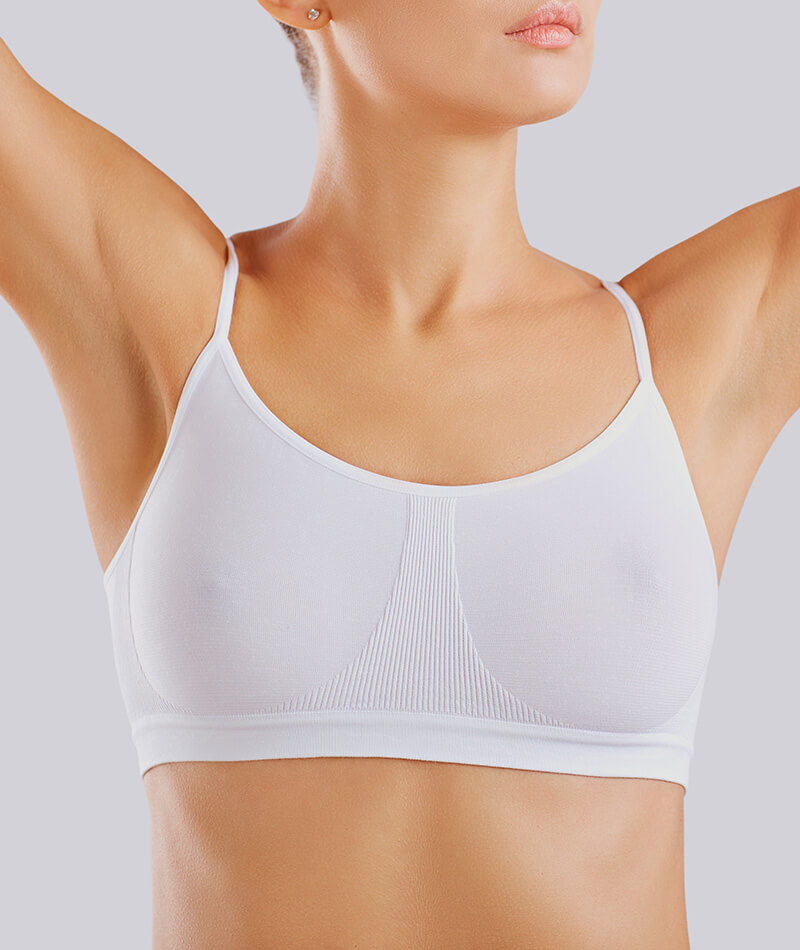During TUG/DUG flap reconstruction, skin, fat, and their blood supply is taken from the inner thigh and transferred to the chest to reconstruct the breast mound. For the TUG technique, the incision will be made across the inner thigh, while the DUG technique will use an incision angled down the thigh. Using microsurgery, the blood vessels are reconnected to establish blood flow in the chest. The flap is then shaped to look as identical as possible to the natural breast.
TUG/DUG Flap and PAP Flap
TUG/DUG (transverse upper gracilis/diagonal upper gracilis) flap techniques are used to reconstruct the breast using the patient’s own tissue. The two techniques take tissue from the inner thigh, as opposed to the abdominal area like other techniques. These techniques are also muscle sparing, using only skin, fat, and their blood-supply during the transfer. Breast reconstruction patients from Washington, DC; Chevy Chase and Bethesda, MD; Arlington and Fairfax, VA; and beyond visit the experienced team at Center for Plastic Surgery for these and many other advanced techniques.



The Benefits of TUG/DUG Flap
The TUG/DUG flap techniques offer an alternative to tissue expanders and implant use for a natural looking and feeling breast. Important muscles are spared during this technique, sacrificing only a small part of the muscle from the inner thigh, reducing the risk of muscle weakness after surgery. The incisions during this technique are on the inner thigh where they are well hidden.
Who Is a Candidate?
Candidates for TUG/DUG flap reconstruction are typically those who do not have enough abdominal tissue to have a DIEP or SIEA flap procedure. Patients who have already had a DIEP or SIEA flap or other abdominal procedure in the past can benefit from the TUG/DUG technique for their reconstruction. To be a successful candidate, patients must have enough tissue in the upper thighs for the transfer. These techniques are ideal for patients with small to medium sized breasts, as only a moderate amount of tissue will be taken.
A Reputation Built on Results

ESTABLISHED EXCELLENCE
Choose the experts that locals know and trust. Our multigenerational practice includes board-certified plastic surgeons who provide the best possible care with state-of-the-art technology.
The Procedure
Results and Recovery
After TUG/DUG flap reconstruction, patients might experience swelling, bruising, and soreness in the donor site and the reconstructed breast. Because no important muscles were affected, patients do not have to worry about permanent muscle weakness after the procedure.
PAP Flap
What Is PAP Flap?
PAP flap is an autologous breast reconstruction technique using the profundal artery perforator blood vessel in the thigh. Along with the blood vessel, skin and fat from the upper thigh are taken as well to reconstruct the breast mound. This is a muscle sparing technique, leaving the thigh muscle intact. Breast reconstruction patients from Washington, DC; Chevy Chase and Bethesda, MD; Arlington and Fairfax, VA; visit the experienced team at Center for Plastic Surgery for this and many other advanced techniques.
The Benefits of PAP Flap
This technique allows for a natural looking and feeling breast without the use of muscle. By sparing the muscle, recovery is often shorter and there is a lower risk of muscle weakness after the operation. taking the flap from the upper thigh area leaves a scar that is well hidden within the natural crease of the buttocks. Blood vessels in this area are lengthy, giving the surgeon more control over tissue positioning.
Who Is a Candidate?
This technique is ideal for women who want to utilize a muscle sparing flap, but do not have enough abdominal tissue. PAP flap is also commonly used on those who have had a previous abdominal surgery, making them poor candidates for an abdominal flap. To be a good candidate for PAP flap, patients must have enough excess tissue in the upper thigh area. The PAP flap technique works best for women with small to medium sized breasts.
The Procedure
During a PAP flap procedure, a section of skin, fat, and their blood vessels are taken from the back of the thigh, just below the buttocks. The tissue is then moved to the chest to reconstruct the breast mound. Using microsurgery, blood flow will be restored to the blood vessels.
Results and Recovery
After PAP flap reconstruction, patients can expect some swelling, bruising, and soreness in the breast and thigh. Tightness in the thigh is also common, but this should improve over the next few months. Patients will need to avoid certain movements that could strain the incision sites and should refrain from strenuous activity for about six weeks. A complete list of aftercare instructions and physical restrictions will be provided. A scar will be left in the crease of the buttocks, but this should be well hidden and continue to fade with time.
Schedule Your Complimentary Consultation
To meet with a surgeon in person, request a complimentary consultation using our online form. CPS has been helping patients feel more confident since 1986. We pride ourselves on providing a comfortable, caring environment for our patients.